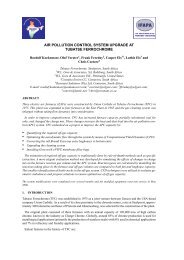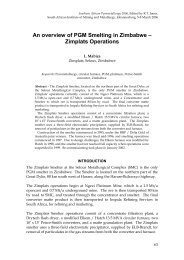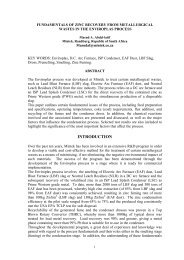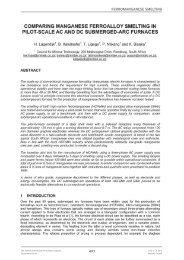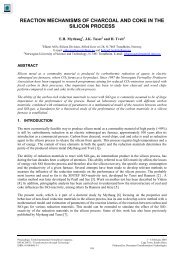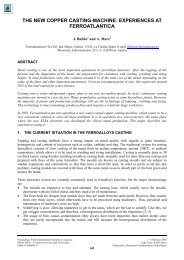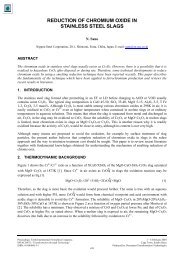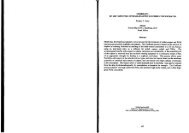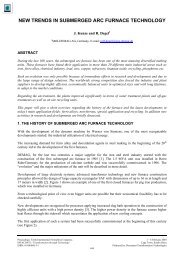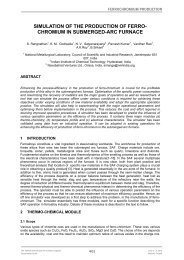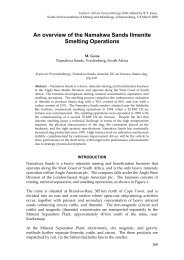ferro alloy design, ferro alloy selection and utilisation ... - Pyro.co.za
ferro alloy design, ferro alloy selection and utilisation ... - Pyro.co.za
ferro alloy design, ferro alloy selection and utilisation ... - Pyro.co.za
- No tags were found...
Create successful ePaper yourself
Turn your PDF publications into a flip-book with our unique Google optimized e-Paper software.
Applications <strong>and</strong> Uses6 PROCESS MODEL USED FOR SIMULATIONS1.7 GeneralUTCAS is an advanced <strong>co</strong>mputer system specially <strong>design</strong>ed for the <strong>co</strong>nverter process management.The system <strong>co</strong>ncept includes an effective real-time process <strong>co</strong>ntrol system as well as tools forprocess <strong>design</strong> <strong>and</strong> production evaluation, see figure 4. It is used for stainless steelmaking productionprocess <strong>co</strong>ntrol <strong>and</strong> for process <strong>design</strong> in Outokumpus Avesta Works as well as in Acerinox’sColumbus Stainless Works.Figure 4: The UTCAS <strong>co</strong>ncept for process <strong>co</strong>ntrol <strong>and</strong> management [4].1.8 Process modelsThe UTCAS system includes a set of highly sophisticated metallurgical models capable ofdetermining heat <strong>and</strong> mass balance <strong>and</strong> chemical <strong>co</strong>mposition <strong>co</strong>ntinuously during the process. Themodels are also used to generate a forecast – a prediction – of the final temperature <strong>and</strong> slag/metal<strong>co</strong>mposition based on planned gas blowing <strong>and</strong> additions. The prediction is used as a valuable toolwhen <strong>design</strong>ing the process prior to production <strong>and</strong> also during processing by optimizing <strong>and</strong><strong>co</strong>ntrolling the process in order to meet the final targets. The <strong>co</strong>re of these models is based onSjöbergs work [5].In the installations mentioned above, the models have been used in the production of severalthous<strong>and</strong>s of heats of various grades. The calculation results are <strong>co</strong>ntinuously verified by samples<strong>and</strong> measurements <strong>and</strong> shows good <strong>co</strong>rrelation.1.9 SimulationThe same models as described under 6.2 can be <strong>co</strong>nfigured as an off-line simulator providing anenvironment for analyzing the effects <strong>and</strong> results of various potential process scenarios such asadding different specific materials at different stages during the process.Since the models in such a simulation are capable of calculating on all significant <strong>co</strong>nsequentialeffects, such as total gas <strong>co</strong>nsumption <strong>and</strong> the required amounts of reduction agents, slag formers<strong>and</strong> additional <strong>alloy</strong>s, the total <strong>co</strong>st for each case can easily be determined.It is in this <strong>co</strong>nfiguration that UTCAS has been used in this paper. The results from the simulations areshown in tables 2 <strong>and</strong> table 3.The Twelfth International Ferro<strong>alloy</strong>s CongressSustainable Future924June 6 – 9, 2010Helsinki, Finl<strong>and</strong>



